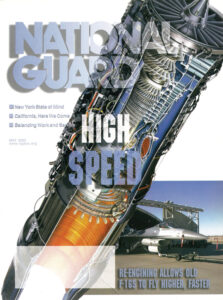Magazine Archives
Packing New Power
 The first Air National Guard F-16 fighter to be retrofitted with a more powerful Pratt & Whitney F100-PW-229 engine took off at the international airport here on a crisp afternoon in March.
The first Air National Guard F-16 fighter to be retrofitted with a more powerful Pratt & Whitney F100-PW-229 engine took off at the international airport here on a crisp afternoon in March.
It was, as one observer put it, “a kick-ass flight.”
In fact, the aircraft, piloted by Maj. Edward Cassidy of the 416th Flight Test Squadron Edwards Air Force Base, Calif., performed flawlessly during the 1.3-hour flight. It landed “Code One,” or no write-ups.
“We really beat the crap out of that airplane and its brand new engine,” Cassidy said, but performance of all systems was perfect.
At 20,000 feet, he checked out the system that would start the motor if it ever quit in flight. At 30,000, he put the engine computer through its paces, forcing the engine to rapidly move through performance levels and then back to idle.
Finally at 40,000 feet, he went supersonic and then some, “to make sure the engine can swallow all the air without coughing or burping.” It could, and did.
In addition to providing a good show, the flight underscored the benefits that accrue to the Guard and the nation once all three squadrons of “Block 42” F-16s receive the new engine.
Now in the second year of a four-year re-engining program, the need for increased thrust and more reliable aircraft in the Air National Guard has never been greater, just as demands on the Guard have never been greater. Between overseas deployments and homeland defense, the Guard faces its most daunting challenges.
The re-engining program is one of the most cost-effective ways of supporting the Guard in its new role. The older F100-PW-220 engines being replaced are retrofitted onto other Guard aircraft that fly earlier model F100 engines on their F-15Cs. Passing the replaced engines down to these aircraft saves substantial money and advances the goal of modernizing aircraft across the fleet, say Guard officials.
F-16s and other aircraft reach the Guard in “blocks” that differ from one another in terms of airframe, engine and weapons delivery capability. The Block 42 F-16s belong to Guard units in Iowa, Ohio and Oklahoma, while units in other states fly F-16s with other designations. The engine constitutes a principal difference among blocks; some fly versions of the General Electric F1110 rather than a Pratt & Whitney engine, for example.